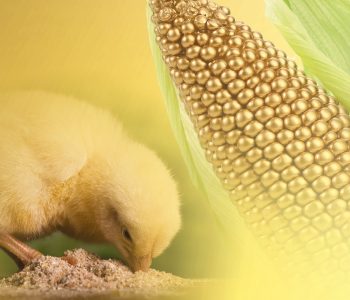Nutritional Importance of Corn Quality in Broiler Diets
Approximately 70% of the world’s produced corn is destined for animal feed (EMBRAPA, 2006). It serves as the most important energy component in the diet of broiler chickens, constituting one of the most prominently included ingredients in diets, contributing around 65% of metabolizable energy and 20% of crude protein (Cowieson, 2004).
In terms of its morphology, the corn kernel can be divided into::
- Endosperm, germ (embryo);
- Pericarp (husk) and tip, which differ in chemical composition and organization within the grain.
- On a dry weight basis, corn typically consists of approximately 72% starch, 9.5% protein, 9% fiber, and 4% oil (EMBRAPA, 2006); however, these ratios might exhibit variations.
The vitreous and starchy endosperm section encompasses the starch component and certain storage proteins, accounting for roughly 80% of the grain’s composition.
Figure 1. Layers and internal structure of the maize kernel (Merriam-Webster Inc. 2006).
Figure 2a. Vitreous endosperm. Sources: Holding, D. R., 2014; Sementes biomatrix
Figure 2b. Starchy endosperm. Sources: Holding, D. R., 2014; Sementes biomatrix
Both starch and protein digestibility can be compromised due to difficulties in accessing starch granules. The structural difference between starchy and vitreous endosperm, mainly characterized by the protein matrix profile, can impact the grain’s nutritional value (Tamagno et al., 2016), with protein content being higher in the vitreous endosperm (Gayral et al., 2015).
Starch
Starch is a polysaccharide composed of glucose units, organized within the granule as structures called amylose and amylopectin (Weurding et al., 2003; Isaksen et al., 2011). In the case of corn, amylose makes up around 25% of the starch content, featuring a linear chain of glucose units interconnected by alpha-1-4 bonds.
- Amylopectin shares the same glucose composition as amylose; however, it distinguishes itself through structures that contain alpha-1-6 branch connections, constituting 70 to 80% of the remaining starch content.
Due to structural and bonding characteristics, enzymes can access amylopectin more easily compared to amylose, making it more digestible (Svihus et al., 2005).
RS, in turn, can be divided into other categories.
Starch Digestibility
The level of starch digestibility is a subject of debate; certain researchers reported values approximately at 85% (Garcia et al., 2003), whereas others attain values of 95% (Soto-Salanova et al., 1996). This divergence can be attributed to factors such as cultivar diversity, plant growth conditions, and spatial organization of starch polymers (Penz Jr., 1998). Nevertheless, this difference in values may be linked to the methodology employed.
Corn grain digestibility can be affected by the amylose:amylopectin ratio due to processing type, starch gelatinization, and retrogradation (Bjorck et al., 1994).
| According to Carré (2004), corn has a low concentration of antinutritional factors like phytate and non-starch polysaccharides (NSPs), and its digestibility can be influenced by particle size after grinding and granule structural variation. Hauschild et al. (2006) show that nutrient digestibility and absorption can be altered by mycotoxins, negatively affecting animal performance. |
Research indicates that animals with rapid growth rates exhibit lower efficiency in starch digestion due to the birds’ voracity. This eagerness affects the digestion and absorption of nutrients by influencingthe gastrointestinal tract passage rate (Duke, 1986; Rougière et al., 2009).
Therefore, the elements that impact starch utilization encompass amylase secretion and the volume of ingested feed.
Corn Quality
The quality of corn is crucial in formulating diets for broiler chickens, as not only is it regarded as the primary energy component in feeds, but its poor quality can also compromise animal performance.
- The sequence of production, grain processing methods, and the source of origin collectively possess the capacity to exert an influence on the chemical composition of the corn grain and its nutritional makeup (Mazzuco et al., 2002).
According to the studies conducted by Rodrigues et al. (2003), the digestibility of nutrients and the energy values of diets varied based on the composition of corn used in the formulation of diets for broiler chickens.
Leal (2012) evaluated the chemical and physical characteristics of corn with varying levels of fungal contamination (fermented/moldy) and whole grains, along with the effects of using these grains in broiler chicken diets.
The physical characteristics of corn, alongside its moisture content, the presence of mycotoxins, the proportion of fractured, moldy, decayed, or contaminated grains, along with various other aspects, possess the potential to alter the nutritional constitution of corn. As a result, this can subsequently influence the quality of feeds supplied to broiler chickens, ultimately resulting in a decline in their performance (Silva, et al., 2008).
| The utilization of poor-quality corn can impact the final phase of the birds’ production cycle, resulting in economic losses. In their observations, Stringhini et al. (2000) noted that corn harboring various insect or fungal infestations brought about an elevated occurrence of metabolic challenges in the avian population. This, in turn, led to an increased rate of carcass rejection at the processing facility. |
Bibliographical references available upon request.
This article was originally published as content in portuguese on nutriNews Brasil 2023
You may also like to read: “UNDERSTANDING CORN VARIABILITY: PART I”
